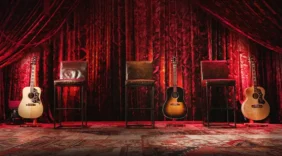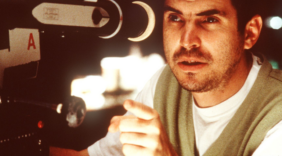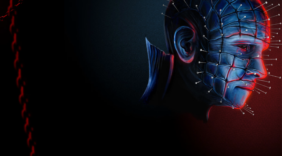Crafting the World of The Chosen: A Conversation with James Cunningham
Written by on Mar 21, 2025 12:00 PM

From humble beginnings to becoming the greatest historical drama chronicling the life of Jesus, The Chosen continues to captivate audiences worldwide. This dedication to creating a series with compelling storytelling, high production value, and relatable characters has captured the hearts of millions, who are drawn not only to the portrayal of Jesus but also to the richly detailed historical settings – masterfully brought to life by Production Designer, James Cunningham.
Known as the “king of period piece set design,” Cunningham understands the importance of worldbuilding, often spending months researching the history of each location to create something that was contemporary to the Bible. With The Chosen: Last Supper (Season 5) premiering in theatres starting March 27th, we sat down with James Cunningham to talk about his craft and how he goes about shaping the world of this incredible series.
How did a “farm boy” from Wisconsin end up as the Production Designer for The Chosen?
Dallas and I were roommates in college. After graduation, he asked me to come out and work on his first short film, Cliche. When I arrived on set, we found out the Production Designer’s father had passed away and Dallas asked if I wanted to fill in for him. Hesitantly I said yes, as I had no idea what a Production Designer did. Somehow, I pulled it off and almost 25 years later, after all the hard work and hard knocks, I’m still working as a Production Designer.
What are some of the biggest lessons you’ve learned throughout your career as a Production Designer?
We know it is really important to build texture and depth in a set, take us through your process of translating Dallas Jenkins’ vision into something tangible?
The process always starts with the script and what it’s telling us to create. I typically begin with the initial breakdown, reading it and envisioning where the sets are going to go in existing locations (Goshen, UT, our city backlot, or a set that has already been created).
After that, if any new sets need to be built, I’ll draft a design based on what the script is calling for: focusing on how the characters will interact with the space, how many of them will be on set, and any historical/biblical information I’ve found during my extensive research.
Once the initial concepts and designs are finished, I’ll send them over to our set designers – who draw up the concepts to present to Dallas. After everything is finalized and he approves the locations, we move to the drafting and building stage.
You’re known as the “king of period piece set design,” what kind of research goes into creating these sets?
Quite a bit of research goes into each set. For any given production I like to delve into whether it actually existed, researching the culture of the time and how that affects a location. This requires me looking into the archaeological records and pictures. For instance, when we built the city, we studied Pompeii and Herculaneum, which were contemporary Roman cities that were destroyed not long after Christ in 79 AD – these were contemporary to Jesus.
I’ve also read a lot of work from various authors of the time – from Roman writers to Flavius Josephus, who was a historian at the time of Christ. My undergraduate work was in ancient history, so I have always been a bit of an ancient history nerd. I also study the Bible quite extensively which helps with a lot of the cultural aspects of the Jews and how they lived under the Romans etc.
How big is your team and how much do you coordinate with the Director of Photography, Akis Konstantakopoulos?
For Season 5 my entire team – consisting of the art department, set decoration, props, construction, greens, etc. – was at the most 120 people. I do work very close with Akis. From the beginning, after I make my initial map of where sets are going, we sit down and read through each scene carefully – collaborating on where we want each scene, what the locations will visually look like, the lighting, how many people, and what the movement will be.
Once the designs have been drafted, Akis and I go through them with the Art Director and look at the placement of sets on the stage to ensure we have enough space for lights. We go through each design and talk about windows, ceilings, torches, candles, and lanterns to plan out what type of lighting will be on each set and how it will be used. All measurements are agreed upon before we can start building.
What were some challenges your production team encountered on Season 5?
One of the main challenges we faced when designing Season 5 was the scope. My team and I were moving out of Capernaum, and the story was shifting to Jerusalem – everything had to be bigger in scale. We wanted the audience to notice the difference. More wealth, money, and power – which usually equates to bigger spaces. With all this in mind, we had to take our small backlot and reskin much of the city to make it fit the scope of the season. This turned into adding three big exteriors – the upper room exterior, Caiaphas’ exterior, and Pheobe’s exterior.
Doing all this created the challenge of finding the time to build it all. To make up for that time, we had to start our filming in Utah. Preparation consisted of building sets for both Texas and Utah, keeping one team building in Texas – who sent set pieces up to Utah – where another team constructed it. Utah was a challenge early on because of the cold weather in March when we arrived. The scenic designers had to add antifreeze to the paint so that it didn’t freeze while they were applying it.
This meant that I had to fly back and forth while this was happening. We then had a team clean up in Utah while the rest of us moved back to Texas to finish building. Weather was also a challenge; we had record rains in the spring, so the streets of our city was often flooded and very muddy which caused a lot of problems for the production.
Are there any hidden details in Season 5 that viewers should be on the lookout for?
I think one thing people might be shocked by is the fact that we built the Garden of Gethsemane on the stage.
Pheobe’s house also had a mural painted on the walls in the main courtyard, so if viewers know the story of Orestes, they might be able to piece it together while watching the show.
People may also notice that Pilate’s bedroom got a remodel from Season 3. It was too difficult to film on the second story in the city, so we had to build the bedroom on the stage.
Are there any sets from Season 5 that will be added to the new tour?
The most notable new sets added to the tour would be the exterior/interior of the Upper Room, exterior/interior of Caiaphas, and exterior/interior of Phoebe’s home.
What were some of your favorite moments from Season 5?
I have to say one of my favorite moments was when we filmed the Last Supper. I was struggling with what this iconic location would look like. It had been painted so many times over the centuries, and some of these depictions are iconic themselves. The actual upper room had been destroyed in 70 AD during the destruction of Jerusalem. Much of the city including the temple were destroyed. The spot where it is today was the Byzantine rebuilding on top of the old site.
I knew I wanted to take elements from that building because it was easily recognizable. I came up with an initial design, but a week before we started construction, we realized there wasn’t enough room in the space to light it properly. This required me to quickly redesign the set to fit those needs and I wasn’t sure how it would translate to film in the end.

The day we filmed I came to open set and make sure everything was ok. When the first shot was lit and ready to go, I was watching the monitor, and I started to cry. It was so beautiful and the arches in the room framed the actors and table like a painting. I was so relieved, the iconic set turned out better than I had hoped. I had to leave set for a bit because I was crying.
Why does The Chosen: Last Supper need to be seen on the Big Screen?
One word for Season 5 is… Epic! It was filmed with an anamorphic lens, meaning the shots have a much wider view than traditional film. The story is building up to the crucifixion, so the stakes are getting higher for Jesus and the disciples. We created the sets to be bigger, and more colorful than previous seasons. All departments and actors brought their A game this season, and personally I feel the writing has been the best it ever has been.
Sign up for our newsletter to keep up to date with all our screenings.




"*" indicates required fields